Which of the following is not a function of synovial fluid?
(a) Shock absorption
(b) Nutrient distribution
(c) Maintenance of ionic balance
(d) Lubrication of the articular surfaces
(e) Waste disposal
 Verified step by step guidance
Verified step by step guidance Verified video answer for a similar problem:
Verified video answer for a similar problem:



 1:19m
1:19mMaster Introduction to Classification of Joints with a bite sized video explanation from Bruce Bryan
Start learning